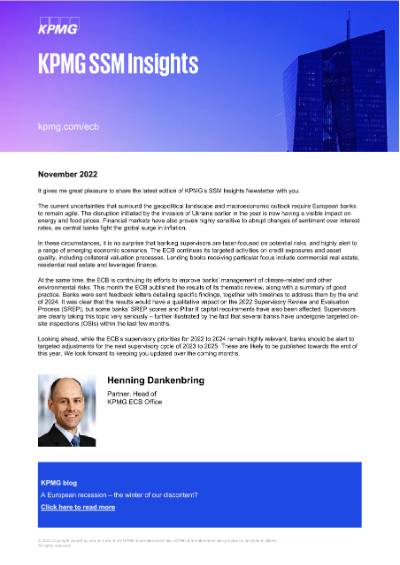November 2022
Despite the volatility of 2022, European credit quality has remained relatively resilient until recently. Now however, EU regulators are increasingly concerned about the credit risk impact of high inflation and a looming recession.
KPMG firms’ banking clients across Europe continue to experience a range of credit-focused supervisory activities. In recent months these have evolved from monitoring the lagging effects of the pandemic to addressing the emerging risks from geopolitical and macroeconomic uncertainty – especially in energy-intensive sectors and the most interest rate-sensitive portfolios.
This article discusses recent supervisory activities around interest rate and credit spread risks, commercial real estate, residential real estate, and leveraged finance.
Rising interest rates and widening credit spreads are threatening banks’ asset quality
The latest ECB Economic Bulletin shows that banks' lending rates for both households and businesses have increased further, as banks’ tighten their loan supply and credit standards amid concerns over rising risks. As financial conditions tighten, this is expected to put additional strain on the more-indebted borrowers. This is likely to put additional pressure on banks’ asset quality and credit risk. In recent months, interest rates and credit spreads have also reached levels not seen for a decade. Tighter monetary policy is predicted to continue to push up banks’ wholesale funding costs, further widening credit and government spreads and accentuating the risks to banks’ exposures.
To monitor these risks, the ECB has initiated a review of interest rate and credit spread risks. This aims to assess banks’ exposures, risk appetite and risk management. The first phase comprised a “top-down” and “bottom-up” assessment and resulted in 31 banks being placed under further scrutiny. These banks are undergoing a targeted horizontal review covering multiple modules, which began in May 2022 and will be completed this year. The conclusions and findings will be integrated into the Supervisory Review and Evaluation Process (SREP) 2023 and taken into account for additional supervisory activity.
Commercial real estate remains a key focus for the ECB
One sector of particular concern for the ECB is commercial real estate (CRE). The ECB considers that
Stay up to date with what matters to you
Gain access to personalized content based on your interests by signing up today
CRE already accounts for as much as 30% of European banking non-performing loans (NPLs), partly due to legacy loans left over from the financial crisis of 2007-08. There is now unease over the additional strain that higher interest rates and the anticipated downturn will put on the sector. Supervisors are therefore stepping up their monitoring of banks’ CRE loans and underlying collateral valuations.
One element of this is the programme of on-site inspections (OSIs) which has been ongoing since 2018 and includes collateral re-valuation. So far this has targeted 40 banking groups, and new phases of OSIs are planned for the rest of 2022 and into 2023. In addition, in 2021 the ECB began CRE-targeted reviews focusing on the management of emerging risks in CRE portfolios, both for offices and retail. This new exercise covered 32 banks initially, and more to be added in the second phase. The first assessment identified a range of emerging CRE-related risks, which are expected to inform future supervisory activities. The ECB also identified many challenges to CRE risk assessments, including market complexity and data gaps.
Concerns over price corrections in residential real estate
Residential real estate (RRE) is a major component of European bank lending. Loans and advances collateralised by residential immovable property represent around a third of all loans to households and non-financial corporates, totalling about €4.1 trillion1. Banks’ mortgage portfolios exceed 200% of Common Equity Tier 1 (CET1) capital in most euro area countries2.
The European Banking Authority (EBA), the ECB and the Bank of England are now raising concerns over vulnerabilities in this segment, and especially over potential corrections of RRE prices in some markets. An ECB analysis of the long-run equilibrium relationship between demand and supply estimated that euro area house prices were 10% above equilibrium in Q1 2022. This could lead to a downward correction, potentially compounded by additional falls in housing demand. Further deterioration in financing conditions might also accentuate risks from household indebtedness.
The EBA has underscored the importance of supervisors and banks continuing to watch their mortgage portfolios closely. Banks are advised to exert prudence over loan origination, and to enhance loan monitoring. This includes having robust mechanisms that allow early identification and intervention of unlikely to pay loans, and performing timely recognition and adequate provisioning against loan losses.
Leveraged finance risks could lead the ECB to impose capital charges
Supervisors continue to view leveraged finance as a major risk to European banks. The ECB recently highlighted that significant institutions in the euro area now hold over half a trillion euro of leveraged loans, an increase of 80% from 2017 when the ECB published its Guidance on Leveraged Transactions (LT). On aggregate, leveraged loans held by significant banks now represent around 60% of CET1. The ECB is concerned that banks are heavily exposed to vulnerable corporates, which may struggle to service their debt or refinance in the higher interest rates and wider credit spreads.
In March 2022, the ECB sent a “Dear CEO letter” to significant institutions stressing the expectations set out in its LT Guidance. Some banks were asked how they plan to mitigate the vulnerabilities identified in the letter. The initial assessment of responses reveals some important deficiencies in banks’ overall risk appetite frameworks, and in the recognition and management of market risks.
The ECB is planning to work closely with banks to agree how to close these gaps. The assessment is supposed to feed into the SREP, with capital charges for banks seen as having excessive leveraged lending risks.
Looking ahead: all the signs point to an intensive supervisory focus on credit risks
The heightened level of credit-focused supervisory activity at KPMG firms’ banking clients, together with the ECB’s priorities for tackling new and emerging risks, means that current levels of regulatory focus are expected to continue into 2023 and beyond. To help ensure they are prepared, banks can:
- Ensure that risk management frameworks covering interest rate and credit spread risks are robust;
- Identify and address any data gaps relating to CRE loans and collateral valuations;
- Review the adequacy of early warning indicators for RRE loan portfolios; and
- Address any weaknesses identified in the management of leveraged loan portfolios.




